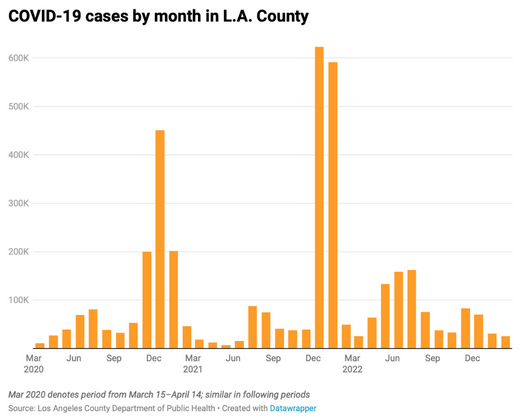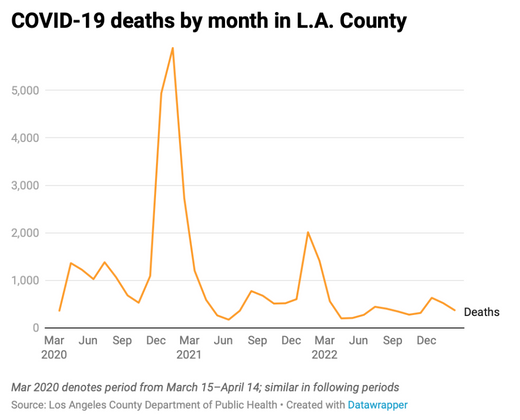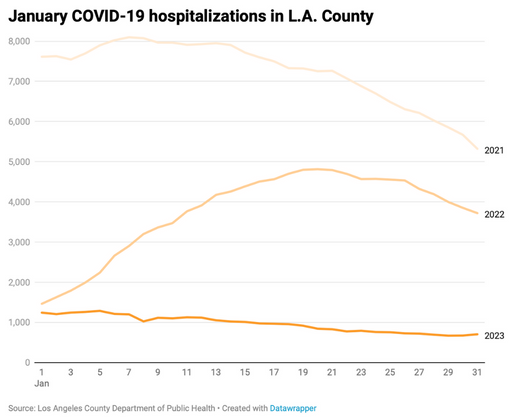A look back at three years of COVID-19 in Los Angeles

It was easy to overlook last week, but March 15 marked three years to the day since then-Mayor Eric Garcetti ordered restaurants in the city of Los Angeles to halt in-person service, and bars, theaters and other businesses to close in the face of the rising coronavirus threat. It would mark the beginning of an unpredictable period where cases and deaths would soar and decline.
Here is Crosstown’s look back at the turns and toll COVID-19 had on Los Angeles County.
Cases
Since the beginning of the pandemic, the Los Angeles County Department of Public Health has reported more than 3.7 million cases. This only includes those recorded by the county. Many infections diagnosed through at-home tests, particularly in the last year, were never publicly reported.
Even though climbing counts had people frightened in the early months, nothing could prepare the region for the first winter: In January 2021, before vaccines were widely available, there were more than 15,000 average daily cases.
The low occurred in June 2021, when the seven-day average briefly dipped below 200.
There were other peaks and valleys, often tied to when a new variant emerged. The greatest spread occurred with Omicron, and in January 2022 the county averaged more than 40,000 daily cases. Yet despite the higher numbers, the widespread application of vaccines meant fewer people suffered severe symptoms or died than in the previous year.

In year three there was a summer spike, but then cases went back down. A surge similar to what happened in the first two winters never materialized.
On March 14—the final day in the three-year span—the seven-day case average was 759. That was the lowest count since April 2022.
[Get COVID-19, crime and other stats about where you live with the Crosstown Neighborhood Newsletter]
Deaths
The overall toll on life is so immense that the number barely makes sense: To date, nearly 36,000 people in Los Angeles County have died from COVID-19.
More than one in three of the total deaths occurred that first winter, which again was before most people could get vaccinated. In January 2021 alone, 6,473 Angelenos passed away due to COVID-19.
Another spike occurred the following winter, though it did not approach the initial peak.
Since the start of the pandemic, the lowest seven-day average for COVID-19 deaths has been four. That came July 1-6, 2021.

As of March 14, the seven-day average of fatalities in Los Angeles County was 10.
Hospitalizations
The Department of Public Health began reporting COVID-19 related hospitalizations in May 2020. As with cases and deaths, there have been low periods and dizzying spikes. The high was the more than 8,000 hospitalizations reported on a single day in January 2021.
Once again, vaccines had an impact. They became widely available in the summer of 2021, and while some people suffered dire consequences, many of those who contracted COVID-19 never required high-level medical treatment.
Still, there were nearly 5,000 hospitalizations reported on a single day in January 2022.

This winter, hospitalizations declined during January. They dropped by 43.3% over the course of the month.
On March 14, according to the County Department of Public Health, 474 people were in area hospitals with COVID-19. The last time hospitalizations were this low was early November.
Positivity rate
In the early days of COVID-19 it was nearly impossible to get a test. Eventually they became more widely available, though appointments at county-run sites or special test centers were required. Now, of course, almost everyone has a stack of home tests.
The Department of Public Health started publishing the daily test positivity rate in January 2021—it was 21.8% on Jan. 6 of the year. It gradually dropped, all the way down to 0.3% in late May. The Omicron surge in January 2022 brought the level back to 22.4%.
Once again, figures this January were below those of the past, never eclipsing the 16.1% on Jan. 3.
The rate has steadied around 5% in recent weeks. On March 14, it was 4.8%.
Taking shots
The first COVID-19 vaccines became available in December 2020, though they were limited to front-line medical professionals. Supplies were tight for months, reserved for senior citizens or people with health conditions. In early 2021 people would show up at vaccination sites at the end of the day, hoping to access “leftover” doses.
Then production ramped up, and in May 2021 the county began rolling out vaccinations to people 12-15 years old. In October, kids 5-11 became eligible. The following June, vaccines were available for those over 6 months.
According to the County Department of Public Health vaccine dashboard, 81% of county residents have received at least one dose of the vaccine. About 74% are fully vaccinated, and 43% have received at least one additional shot.
Altogether, more than 21.5 million doses have been administered in Los Angeles County. The peak occurred in March 2021, when more than 1.7 million people received a jab in the arm. In February 2023, only 4,521 shots were administered.
The bivalent booster has been available in the county since last September. This protects against the original COVID-19 strains as well as Omicron variants. The peak for this booster occurred in October, when more than 500,000 Angelenos took the shot.
Since then, COVID-19 vaccinations of all types have declined.
How we did it: We analyzed coronavirus data related to new cases, deaths, hospitalizations and vaccinations provided by the Los Angeles County Department of Public Health.
Interested in our data? Check out the Crosstown coronavirus interactive map or email askus@xtown.la.






